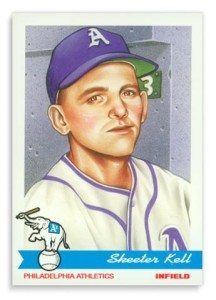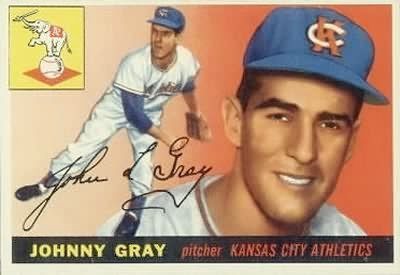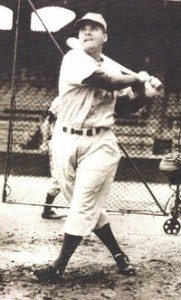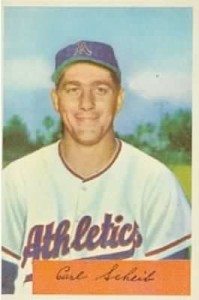One of baseball history’s losses in May was the death of John Gray at age 87. Despite his short career, Gray is in a select group: men who played for two different Philadelphia franchises (Athletics and Phillies).
Philadelphia Athletics
Dick Adams Managed Joe DiMaggio!
If World War II wasn’t incredible enough…
Dick Adams, known as a first sacker with the 1947 Philadelphia Athletics, managed his Army base team. One fellow soldier was none other than Joe DiMaggio.
Adams remembered:
“Yes, I managed Joe DiMaggio in the Army, then played against him in 1947. I was with the Phila A’s. He was with the Yankees.
He was a very quiet person. Didn’t stay on the Base any longer than he had to. Went to Hollywood a lot. He always had gas tickets and tires.”
[The government rationed both in World War II.]
“His baseball skills were VERY GOOD (like always).”
Speaking of Hollywood, Adams has lived a movie-like existence.
First, he lived the major league dream with brother Bobby Adams. Did they talk about playing pro baseball as kids?
“About my brother and me: we went to a tryout camp in Berkeley, Calif. during Easter vacation, 1939. We slept in the car at night, ’cause we never had any $ for hotel rooms, and then we got a $200 bonus for signing (each of us $200).
We thought we were rich. That’s when we talked about playing in the Major Leagues. He had a much longer career in the ‘show’ (14 years) and ended up with the Cubs.
Baseball today is not like it was in my time! Too much $ nowadays. No team play. All ‘me, me, me’ for $ and long-term contracts.”
Although he’s been gone from the diamond for decades, Adams never left the keyboard. A professional pianist beginning at age 13, he keeps sharing his musical gifts today.
“I just returned from playing a luncheon for old, bold pilots — all WWII pilots. Even several German pilots who have become citizens of USA. Quite a nice occasion. By the way, I had four gigs this past week. I still play piano. Big Band music. WWII stuff.”
To learn more of Adams in World War II (and his life after baseball) check out the always-fine “Baseball In Wartime.”
Coming Friday: Fan and collector Kohei Nirengi, championing America’s Pastime in Japan.
Philadelphia Athletics Pitcher Carl Scheib Explains Requesting Donations For Autographs
I’m not a huge fan of numbers. Statistics can help only so much. That’s why this blog isn’t named “Baseball By The Numbers.”
Likewise, I think that the simple “asks $5 donation per autograph” doesn’t tell the whole story.
I sought out Carl Scheib, who became the youngest player in American League history when he debuted in Philadelphia in 1943 as a 16-year-old hurler.
Is the donation request to discourage autograph requests?
“Heavens, no!” the 84-year-old retiree replied. “I appreciate any mail I receive. I’m grateful to be remembered.”
For any player of Scheib’s era, consider how much — or little — they made in their careers.
I asked what his top salary was.
“Only $11,000, and I had to hold out for that!” he answered. “There were big stars, then so many players who needed second jobs in the winter.”
Without bragging, Scheib added, “We make regular donations to the American Cancer Society (with autograph funds). That’s what my wife had.”
If that’s not enough to get your envelopes ready, Scheib mentioned that any time someone sends him a donation, he tries to include an extra signed card in the reply.
To obtain Scheib’s signature, send $5 per autograph and a SASE to:
Carl Scheib
2922 Old Ranch Rd.
San Antonio, TX 78217
A great illustrated history of Scheib’s life and career can be found at the encyclopedic Philadelphia Athletics Historical Society website.
Everett "Skeeter" Kell Remembers George, One Hall Of Fame Brother

Everett “Skeeter” Kell might have been a Tiger.
The infielder with the 1952 Athletics explained in a moving letter why he wound up in Philadelphia, not Detroit — beside future Hall of Fame brother George.
“Skeeter” replied:
“We were very close. I spent six weeks living with him when I was 18 in Detroit. I worked out with the Tigers each day they were home. Mister (Connie) Mack of the A’s saw me practice and signed me.”
Kell reflected on his short career:
“I enjoyed most of my baseball and made lots of good friends, especially in Philadelphia, and to their homecomings as I was older.
I was not too great on being gone from my wife (now 62 years of marriage)and two sons so much.
This is why I retired, when I was sold to Havana, Cuba and could not take them with me.”
Thanks to artist Ronnie Joyner for sharing his swell creation. More info about Joyner’s artistry and the homecomings Kell mentioned can be found at the Philadelphia Athletics Historical Society website.
Everett “Skeeter” Kell Remembers George, One Hall Of Fame Brother

Everett “Skeeter” Kell might have been a Tiger.
The infielder with the 1952 Athletics explained in a moving letter why he wound up in Philadelphia, not Detroit — beside future Hall of Fame brother George.
“Skeeter” replied:
“We were very close. I spent six weeks living with him when I was 18 in Detroit. I worked out with the Tigers each day they were home. Mister (Connie) Mack of the A’s saw me practice and signed me.”
Kell reflected on his short career:
“I enjoyed most of my baseball and made lots of good friends, especially in Philadelphia, and to their homecomings as I was older.
I was not too great on being gone from my wife (now 62 years of marriage)and two sons so much.
This is why I retired, when I was sold to Havana, Cuba and could not take them with me.”
Thanks to artist Ronnie Joyner for sharing his swell creation. More info about Joyner’s artistry and the homecomings Kell mentioned can be found at the Philadelphia Athletics Historical Society website.



